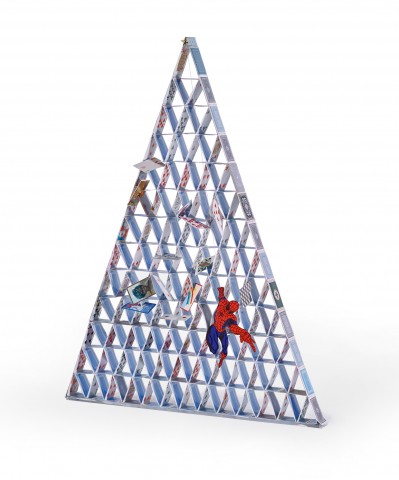WE CAN BE HEROES, FOREVER AND EVER, 2014
TONY ALBERT
vintage playing cards, metal and string
110.0 x 82.0 cm
Sullivan + Strumpf Fine Art, Sydney
Shannon Bennett, Melbourne, acquired from the above in 2014
We Come in Peace: Tony Albert, Sullivan + Strumpf Fine Art, Sydney, 4 – 29 March 2014
Tony Albert is an acclaimed contemporary Australian artist whose varied practice reflects and interrogates the legacy of misrepresentation of indigenous Australian peoples in visual culture. The Girramay, Yidinji and Kuku-Yalanji artist has been collecting mass-produced souvenir trinkets from opportunity shops since his teens, specifically those that he calls ‘aboriginalia’- kitschy mid-century home décor appropriating indigenous designs or objectifying caricatures of indigenous peoples. One of the most prevalent items in Albert’s extensive collection, and one that has formed the basis of many of his sculptural installations, is the souvenir playing card. Arranged into the symbolically rich structure of a house of cards, this historic record of systemic racism acquires a new connotation of activism and resistance.
The house of cards structure was first used by Tony Albert in 2011 with 108, an installation included in the 2014 Adelaide Biennial, Dark Heart, and has recently been revisited in House of Discards, a large-scale sculpture exhibited in The National exhibition in Sydney in 2019. Fragile and whimsical, the house of cards (also known as a card tower, or card castle), is more than being an architectural structure, it is also a figurative expression meaning a structure or argument built on an unstable or untenable foundation. Furthermore, the playing card as a symbol of western gaming, becomes in Albert’s work, a metaphor for the role of chance in determining cultural identity and the opportunities afforded to people by history and circumstance. Bruce Johnson McLean, Albert’s colleague has equated this visual device to the way aboriginal children in particular have been utilized like pawns in Australian politics, “like playing cards at the table of national politics”.1
Although much of Albert’s work is concerned with exposing insincerity and exploitation of first nations Australians, the pervading tenor of his works is one of fragile positivity, hope and optimism. We Can Be Heroes, Forever and Ever, 2014 was one of six houses displayed in the exhibition We Come in Peace, at Sullivan and Strumpf gallery in 2014. The irony of Albert’s title, ‘we come in peace’ (appropriated from science fiction trope from Hollywood), lays bare the enduring peril that Western colonization has placed on first nations people, a far cry from the ideal intentions of ‘civilisation’. By combining the souvenir cards with other visual, and textual elements from popular western culture (video game aliens, superheroes and cartoon animals), Albert repurposes western cultural icons into symbols of gentle indigenous activism.
Tongue-in-cheek and joyfully kitschy, We Can Be Heroes, Forever and Ever, features the stencil-cut figure of Marvel superhero Spiderman leaping out from the crumbling structure of a house of cards, the thirteen levels of which have been compromised by foreign projectiles, other cards featuring offensive imagery. Providing a template for positive affirmation for indigenous youth, Albert uses the image of a cartoon superhero to encourage pride and self-determination in the face of adversity. Redressing the balance of positive representation has been a strong thread within Albert’s practice. By focusing on the acknowledgement of the strength, perseverance and sacrifice of indigenous peoples, Albert proves the ability to persevere and thrive in spite of the structures that disadvantage and discriminate. The figure of Spiderman has recently been re-used in Albert’s practice, in makeshift costumes for indigenous children in the Aboriginal community of Warakurna, in Western Australia. The series Wakurna Superheroes continues the ongoing theme of children creating their own destinies and identities, exploring how we can all battle adversity through strong community engagement and solidarity.
1. McLean, B., Visible, exhibition catalogue, GoMA, Brisbane, 2018.
LUCIE REEVES-SMITH
